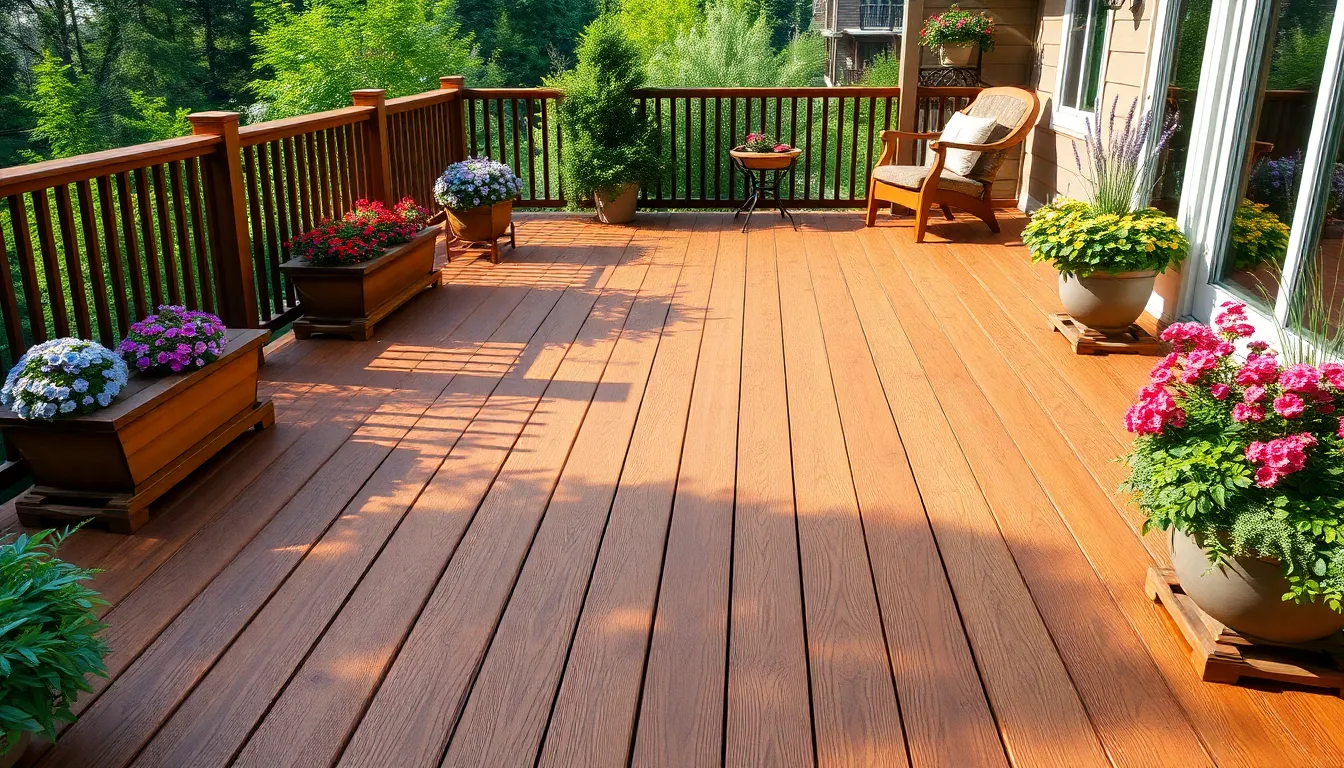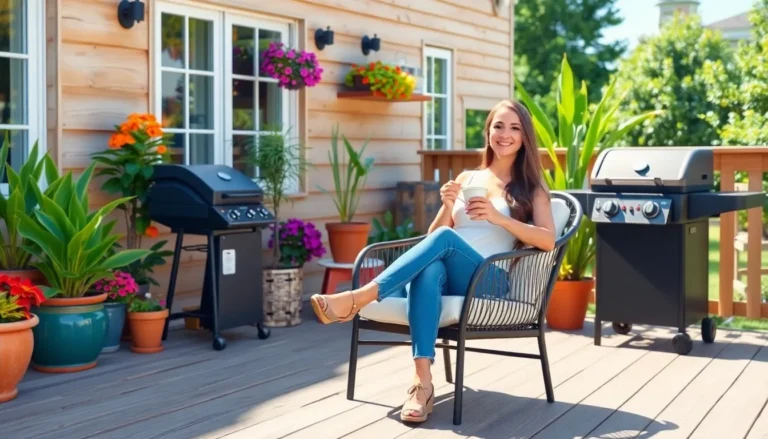Imagine stepping out onto your very own wood deck, the sun shining, a cool drink in hand, and the smell of freshly grilled burgers wafting through the air. Sounds dreamy, right? Wood decks aren’t just a backyard feature; they’re a lifestyle upgrade. They invite relaxation, gatherings, and a touch of nature right at your doorstep.
But let’s face it, not all wood decks are created equal. Some might have you questioning your life choices after a rainy day. With the right materials and maintenance, a wood deck can be your outdoor sanctuary for years to come. So whether you’re a DIY enthusiast or a hiring-a-pro type, it’s time to dive into the world of wood decks and discover how to transform your outdoor space into the ultimate retreat. Get ready to elevate your home and impress your friends—after all, who doesn’t want to be the host with the most?
Table of Contents
ToggleOverview of Wood Decks
Wood decks serve as versatile outdoor living spaces that enhance enjoyment and functionality. They offer a range of aesthetics, from rustic to modern, making them suitable for various home styles. Selecting the right type of wood is crucial for durability and appearance. Common options include cedar, redwood, and pressure-treated pine, each offering unique benefits.
Maintaining a wood deck requires attention to multiple factors. Regular cleaning prevents mold and mildew, ensuring longevity. Proper sealing protects the wood from moisture and UV damage. It’s advisable to inspect the deck annually for signs of wear, such as splintering or loose boards.
Incorporating design elements can further elevate the appeal of wood decks. Adding built-in seating, planters, or outdoor lighting creates inviting atmospheres for gatherings. Customizable railing options enhance safety while adding style.
When considering installation, homeowners can choose between DIY approaches or hiring professional services. Professionals guarantee a level of craftsmanship that reflects in the final look and durability. Those opting for DIY can find numerous resources that simplify the process.
Cost considerations play a significant role in wood deck projects. Average prices range from $15 to $30 per square foot, depending on material choice and complexity. Creating a budget before starting ensures financial feasibility without compromising quality.
Ultimately, wood decks represent a significant investment in outdoor living. With the right planning and maintenance, these structures can provide years of enjoyment and enhance the overall value of a property.
Advantages of Wood Decks

Wood decks offer a variety of benefits that enhance outdoor living spaces. Their warmth and versatility make them an attractive choice for many homeowners.
Aesthetic Appeal
Wood decks provide strong visual appeal. Natural grain patterns and rich colors create an inviting atmosphere. Homeowners can select wood types that match their home’s exterior. Various stains and finishes allow customization, ensuring the deck complements the overall design. Unique features like curved edges or integrated planters add character. This adaptability makes wood decks suitable for both modern and traditional settings.
Natural Feel
Wood decks deliver an organic feel. Unlike synthetic materials, wood maintains a warm texture and appearance. It harmonizes with surrounding landscapes, fostering a seamless connection with nature. Walking barefoot on wood provides comfort that synthetic alternatives cannot match. Seasonal changes enhance the deck’s beauty, as colors shift with time. Being environmentally friendly also adds to wood’s appeal, as sustainable sourcing practices promote responsible forestry.
Types of Wood Used in Decking
Choosing the right type of wood is crucial for building a durable and appealing deck. Various wood options are available, each with unique characteristics and benefits.
Pressure-Treated Lumber
Pressure-treated lumber remains a popular choice for decking. This type of wood undergoes a treatment process that makes it resistant to rot, insects, and weather damage. Most commonly, southern yellow pine is used for this purpose, providing strength and stability. Standard dimensions for pressure-treated boards include 2×6 and 5/4×6 inches. When properly maintained, this lumber can last about 15 to 20 years. Regular sealing enhances resistance to moisture and UV damage. Homeowners should ensure adequate ventilation for longevity.
Hardwoods
Hardwoods offer an attractive option for those seeking durability and visual appeal. Species like ipe, mahogany, and tigerwood are popular for their density and resistance to weather elements. Ipe, renowned for its longevity, can last over 40 years with minimal maintenance. Mahogany, with its rich color and grain, creates an elegant finish. Standard thickness for hardwoods is typically 1 inch and 1.5 inches. Regular oiling helps maintain color and prevent drying. These woods often come with a higher price tag, reflecting their superior quality and longevity.
Maintenance and Care for Wood Decks
Wood decks require regular care to remain in optimal condition. Key tasks include cleaning, weatherproofing, and routine inspection.
Cleaning Procedures
Regular cleaning maintains the beauty and longevity of wood decks. Begin by sweeping off debris to prevent dirt buildup. Using a mixture of warm water and mild soap, wash the surface with a soft-bristle brush. Rinse thoroughly to eliminate all soap residues. For stubborn stains, apply a specialized wood cleaner and scrub gently. Mold and mildew can develop, so it’s essential to address these issues promptly to preserve the wood’s integrity. Annual deep cleaning sessions help prevent moisture retention and maintain a fresh appearance.
Weatherproofing
Weatherproofing protects wood decks from moisture and UV damage. Applying a high-quality water repellent sealer is crucial after cleaning. Select a product specifically designed for wood decks, ensuring it penetrates the grain effectively. Sealing should occur every one to three years, depending on exposure to the elements. Additionally, consider reapplying a UV protectant to minimize fading from sunlight. Inspections during the season can help identify potential issues like splitting or warping. These proactive steps ensure the longevity of the deck and enhance its aesthetic appeal.
Cost Considerations for Wood Decks
Cost represents a significant factor in selecting wood decks. Average expenses range from $15 to $30 per square foot, influenced by material type and deck complexity. Cedar, redwood, and pressure-treated pine vary in price, affecting the overall budget.
Labor costs also play a role. Hiring professionals may increase the total price by $5 to $10 per square foot. DIY installation offers savings, yet it requires skills and time. Homeowners should evaluate personal capabilities versus the quality achieved through professional installation.
Maintenance expenses contribute to long-term costs. Regular cleaning and weatherproofing require investments in materials like sealers and cleaners. Expect to spend $50 to $150 annually on maintenance supplies, depending on deck size and condition.
Wood type impacts initial costs and lifespan. Pressure-treated lumber often presents the lowest upfront pricing, but hardwoods like ipe or mahogany come at a premium. These hardwoods provide longevity, lasting over 40 years with proper care, potentially reducing replacement costs over time.
Permitting fees must also be considered. Local regulations may require permits for deck installation, adding $100 to $500 to expenses. Homeowners should check with their municipalities to ensure compliance.
Ultimately, budget planning for wood decks involves assessing initial costs, labor, maintenance, and potential permitting fees. Balancing quality and affordability ensures a durable, aesthetically pleasing outdoor space that enhances enjoyment and property value.
Wood decks offer a unique blend of beauty and functionality that can transform any outdoor space. By selecting the right materials and committing to proper maintenance, homeowners can enjoy a stunning deck for years to come. The versatility in design and the warm, inviting feel of wood create an atmosphere that synthetic options simply can’t match.
Investing in a wood deck not only enhances outdoor living but also adds significant value to a property. With thoughtful planning and care, a wood deck becomes more than just an addition; it becomes a cherished part of home life.






